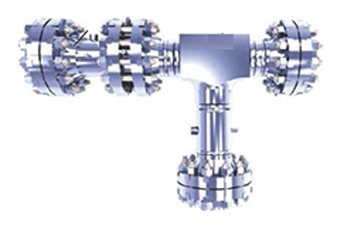Devices for separating continuous gas-liquid flowinto gas flow and liquid flow.
The leading line of activity of EQMAR is using highly-effective engineering solutions, including in-line separators and the unique in-line separation technology.
In-line separator is a device for separating continuous gas-liquid flow into gas flow and liquid flow.
In-line separation uses centrifugal forces and provides extreme purification efficiency. In-line separation enhances the separation process throughput capacity and efficiency whilst improving mass and dimensional characteristics of separation equipment. Assuming that for a similar result, bulky gravitational separators are required, the in-line separators are especially attractive for the projects with limited floor space for equipment installation.
Operation Principle
In-line separators are mounted directly in the pipeline using flange connections and become part of the existing pipeline system.
The in-line separator operation principle is based on using centrifugal forces in axial cyclone.
Gas-liquid mixture is twisted in the tangential swirler, which is installed at the device inlet, and further directed into the cylindrical channel where the liquid is separated at the pipe walls. Liquid film is formed on the walls of cylindrical channel and the gas stream is formed in the near-axial zone. At the outlet of cylindrical channel there is a separating section, where the flow is divided into gas stream and liquid stream. All elements of separator are mounted within the pipeline.

Benefits of in-line separators:
- Small mass-dimensional characteristics, and as a result smaller footprint.
- Inline separators do not require arrangement of sub structures and service areas;
- Wide range of gas flow and liquid phase amount parameters;
- Gas-dynamic elements are made of stainless and erosion-resistant steel, so the equipment is ideal forgases containing aggressive agent;
- High efficiency of dropping liquid separation, achieved by centrifugal forces;
- Easy maintenance: regular inspections and replacement are not required;
- Lowered pressure drop in the separator;
- Reduction in capital and operating costs;
- Possible underwater or offshore use.

